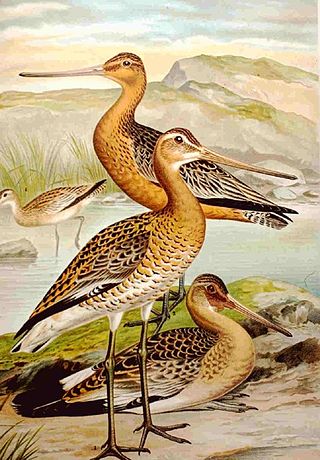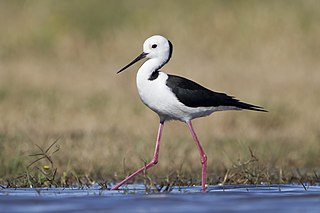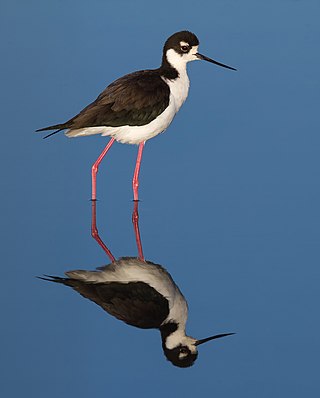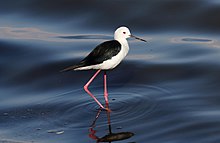
Garrulus is a genus of Old World jays, passerine birds in the family Corvidae.

The godwits are a group of four large, long-billed, long-legged and strongly migratory waders of the bird genus Limosa. Their long bills allow them to probe deeply in the sand for aquatic worms and molluscs. In their winter range, they flock together where food is plentiful. They frequent tidal shorelines, breeding in northern climates in summer and migrating south in winter. A female bar-tailed godwit made a flight of 29,000 km (18,000 mi), flying 11,680 kilometres (7,260 mi) of it without stopping. In 2020 a male bar-tailed godwit flew about 12,200 kilometres (7,600 mi) non-stop in its migration from Alaska to New Zealand, previously a record for avian non-stop flight. In October 2022, a 5 month old, male bar-tailed godwit was tracked from Alaska to Tasmania, a trip that took 11 days, and recorded a non-stop flight of 8,400 miles (13,500 km).

Turnstones are two bird species that comprise the genus Arenaria in the family Scolopacidae. They are closely related to calidrid sandpipers and might be considered members of the tribe Calidriini.

The black-winged stilt is a widely distributed, very long-legged wader in the avocet and stilt family Recurvirostridae. Its scientific name, Himantopus himantopus, is sometimes used to generalize a single, almost cosmopolitan species. Alternatively, it is restricted to the form that is widespread in Europe, Asia and Africa, which equals the nominate group of H. himantopussensu lato. Meanwhile, the black-necked and white-backed stilts both inhabit the Americas; the pied stilt ranges from Australasia and New Zealand. Today, most sources accept between one and four actual species. The taxonomic name Himantopus comes from Greek, meaning "strap-foot" or "thong-foot".

The collared pratincole, also known as the common pratincole or red-winged pratincole, is a wader in the pratincole family, Glareolidae. As with other pratincoles, it is native to the Old World.

The bird genus Balearica contains two extant species in the crane family Gruidae: the black crowned crane and the grey crowned crane.

The banded stilt is a nomadic wader of the stilt and avocet family, Recurvirostridae, native to Australia. It belongs to the monotypic genus Cladorhynchus. It gets its name from the red-brown breast band found on breeding adults, though this is mottled or entirely absent in non-breeding adults and juveniles. Its remaining plumage is pied and the eyes are dark brown. Nestling banded stilts have white down, unlike any other species of wader.

Glareola is a genus of birds in the family Glareolidae. The pratincoles are a group of birds consisting of the seven species of this genus and the Australian pratincole, the only species of the genus Stiltia.

Anser is a waterfowl genus that includes the grey geese and the white geese. It belongs to the true goose and swan subfamily of Anserinae under the family of Anatidae. The genus has a Holarctic distribution, with at least one species breeding in any open, wet habitats in the subarctic and cool temperate regions of the Northern Hemisphere in summer. Some also breed farther south, reaching into warm temperate regions. They mostly migrate south in winter, typically to regions in the temperate zone between the January 0 °C (32 °F) and 5 °C (41 °F) isotherms.

Grus is a genus of large birds in the crane family.

Perdix is a genus of Galliform gamebirds known collectively as the 'true partridges'. These birds are unrelated to the subtropical species that have been named after the partridge due to similar size and morphology.

Asio is a genus of typical owls, or true owls, in the family Strigidae. This group has representatives over most of the planet, and the short-eared owl is one of the most widespread of all bird species, breeding in Europe, Asia, North and South America, the Caribbean, Hawaii and the Galápagos Islands. Its geographic range extends to all continents except Antarctica and Australia.

Porphyrio is the swamphen or swamp hen bird genus in the rail family. It includes some smaller species of gallinules which are sometimes separated as genus Porphyrula or united with the gallinules proper in Gallinula. The Porphyrio gallinules are distributed in the warmer regions of the world. The group probably originated in Africa in the Middle Miocene, before spreading across the world in waves from the Late Miocene to Pleistocene.

Ciconia is a genus of birds in the stork family. Six of the seven living species occur in the Old World, but the maguari stork has a South American range. In addition, fossils suggest that Ciconia storks were somewhat more common in the tropical Americas in prehistoric times.

Manucodes are birds-of-paradise in the genus Manucodia, that are medium-sized with black-glossed purple and green plumages.

Uria is a genus of seabirds in the auk family known in Britain as guillemots, in most of North America as murres, and in Newfoundland and Labrador as turr. These are medium-sized birds with mainly brown or black plumage in the breeding season. They breed on the coasts of the northern Atlantic and Pacific oceans.

The oriole blackbird is a species of bird in the family Icteridae. Its genus, Gymnomystax, is monotypic. It is a medium-sized yellow and black bird found in Brazil, Colombia, Ecuador, French Guiana, Guyana, Peru, Suriname, and Venezuela, where its natural habitats are subtropical or tropical moist lowland forest, subtropical or tropical moist shrubland, subtropical or tropical seasonally wet or flooded lowland grassland, and swamps.

The pied stilt, also known as the white-headed stilt, is a shorebird in the family Recurvirostridae. It is widely distributed with a large total population size and apparently stable population trend, occurring in Malaysia, Japan, the Philippines, Brunei, Christmas Island, Indonesia, Palau, Papua New Guinea, Australia, and New Zealand. It is listed as Least Concern on the IUCN Red List. It is sometimes considered a subspecies of the black-winged stilt.

The black-necked stilt is a locally abundant shorebird of American wetlands and coastlines. It is found from the coastal areas of California through much of the interior western United States and along the Gulf of Mexico as far east as Florida, then south through Central America and the Caribbean to Brazil, Peru and the Galápagos Islands, with an isolated population, the Hawaiian stilt, in Hawaii. The northernmost populations, particularly those from inland, are migratory, wintering from the extreme south of the United States to southern Mexico, rarely as far south as Costa Rica; on the Baja California peninsula it is only found regularly in winter. Some authorities, including the IUCN, treat it as a synonym of Himantopus himantopus.

The Hawaiian stilt is an endangered Hawaiian subspecies of the black-necked stilt species. It is a long-legged, slender shorebird with a long, thin beak. Other common names include the Hawaiian black-necked stilt, the aeʻo, the kukuluaeʻo, or it may be referred to as the Hawaiian subspecies of the black-necked stilt.























